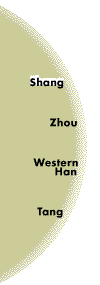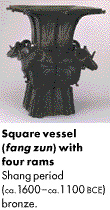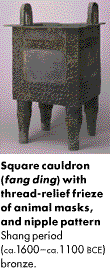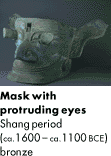

A masterpiece of bronze-casting technology, this vessel, based on a conventional square container, is transformed into an inspired organic form by the ram at each corner. Their heads emerge as fully three-dimensional sculptures, while their chests and front legs appear in relief. Rendered with astonishing realism amid a dense sea of zoomorphic motifs, spirals, and scroll patterns, these complex shapes exemplify the characteristically elegant Shang fusion of abstract and representational animal motifs. Flanges are a purely abstract ornament, but here, running under the rams' chins and down their chests, they also serve as the rams' beards and woolly pelts. Incised birds with tall, scrolled crests cover the rams' bodies, while three-dimensional horned dragons project outward from either side of the ram's heads.


The form and size of these masks are unparalleled and their use is unknown. Nothing similar has ever been found in any other Chinese Bronze Age site. However, the effort and cost of casting them must have been justified by their ritual or spiritual significance to those who made and buried them. Discoveries such as this mask have created great surprises in the archaeological field and have initiated new directions in research, including the reexamination of ancient texts. References in these texts to a mythical people from a territory called Gushu, whose ancestors the Cancong had protruding or bulging eyes, take on new meaning with the discoveries at Sanxingdui.